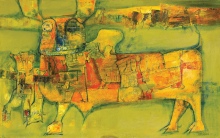(photo credit: The Jehangir Nicholson Art Foundation, Rekha Rodwittiya)
Rekha Rodwittiya’s art underlines a strong feminist position and engages with the socio-politics of the world, says Anjali Purohit
Rekha Rodwittiya has been known to be a painter who engages with the socio-politics of the world, its contradictions and inequalities. Her art underlines a strong feminist position as also her reaction to the many issues that confront women.
In the artist’s words, ‘… I hold as consistent the desire to examine the feminine space of survival, the spirit of female endurance and the empowerment of pride and self-dignity that centuries of feminist oral histories are infused by, as the territory from which my work takes shape’.
The Jehangir Nicholson Gallery, CSMVS, is presenting her work at the show, Songs from the Blood of the Weary (Dialogues of Peace), which will run until mid-August.
Songs from the Blood of the Weary was first created by Rekha as part of an exhibition commemorating the 50th anniversary of the United Nations at Geneva in 1995 which brought together 12 paintings in the form of a painted room. Additional works from the collection of Sakshi Gallery form part of the present show. Together they provide us an understanding of the artist’s journey and the issues that are central to her work.
Rodwittiya says, ‘…in a world where atrocities are committed against women in the name of upholding traditional values, a focus to redress this is vital if we are to define true liberty for all humanity…’.
However, there are ways art can pose a challenge, be disruptive, confrontational and subversive without being destructive. The entire oeuvre of Rekha’s work demonstrates this very fine balance. Rich and nuanced, her paintings do not ‘explain themselves’ or offer a singular narrative but suggest meanings through the placing and character of the figures and the use of metaphor.
The metaphors consist of objects (often repeated like a refrain in a song) and the relative size and structure of human figures on the canvas especially that of women. The woman in Rodwittiya’s paintings is strong and corporeal. This confidence comes from laying claim to a heritage of feminist practice which she has elsewhere described as her ‘gifts of legacy’ where, in her words, ‘my complete belonging is within the womb of my feminist ancestry…’.
A collection of these metaphors is what Rekha describes as her ‘lexicon’ or vocabulary through which she creates her art. Objects such as a spade, fish, scissors, leaves, locks, dice, boats and airplanes, maps, are infused with significance when juxtaposed with human figures that play out a dramatic statement on each canvas—the position and ‘pose’ of the hands and fingers acting as clues or prompts (or ‘mudras’, as Rekha calls them) to the script.
The palette, predominantly red, brown, yellow and grey has been put to great effect in her haunting work, Burnt Earth Yields Strange Fruit. This is the artist’s articulation of her outrage at honour killings, female infanticide and dowry deaths. The title bears a disquieting throwback to the Abel Meeropol poem (sung by Billie Holiday) Southern Trees Bear a Strange Fruit, about lynching in the Jim Crow era. This becomes even more chilling for us today because of growing instances of brutality that have a real danger of becoming ‘normalised’ and not being ‘strange’ any more.
Finally, I leave you with this.
This show is at the JNAF Gallery, which is itself housed in the CSMVS. Tourist buses bring people from the mofussil on a Mumbai Darshan. They are impressed by the ancient museum pieces and then sometimes a family, wanting to investigate what lies in the east wing of the second floor, stumbles into the art gallery. One such large family with several unruly children was there when I visited the exhibition. While the other children ran about chasing each other through the space, I noticed one eight-year-old girl standing, quiet and absorbed, in the ‘painted room’. It was one of those rare private moments that pass without much notice. She didn’t want to leave even after several calls from her father. I believe that while art criticism must play its part in placing an artwork in the context of art history and aesthetic theory, being privy to the sight of this little girl was significant validation as well. I don’t know who she was but did send out a silent wish to her saying, ‘may your tribe increase’.
Anjali Purohit is a writer, painter, poet, translator and conceptual vagabond with a yen for gadding about town.
The column in the ADC48hrs can be viewed here – http://www.afternoondc.in/48-hrs/burnt-earth-yields-strange-fruit/article_223596


























